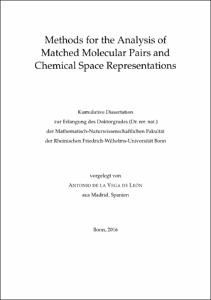de la Vega de León, Antonio: Methods for the Analysis of Matched Molecular Pairs and Chemical Space Representations. - Bonn, 2016. - Dissertation, Rheinische Friedrich-Wilhelms-Universität Bonn.
Online-Ausgabe in bonndoc: https://nbn-resolving.org/urn:nbn:de:hbz:5n-45030
Online-Ausgabe in bonndoc: https://nbn-resolving.org/urn:nbn:de:hbz:5n-45030
@phdthesis{handle:20.500.11811/6905,
urn: https://nbn-resolving.org/urn:nbn:de:hbz:5n-45030,
author = {{Antonio de la Vega de León}},
title = {Methods for the Analysis of Matched Molecular Pairs and Chemical Space Representations},
school = {Rheinische Friedrich-Wilhelms-Universität Bonn},
year = 2016,
month = oct,
note = {Compound optimization is a complex process where different properties are optimized to increase the biological activity and therapeutic effects of a molecule. Frequently, the structure of molecules is modified in order to improve their property values. Therefore, computational analysis of the effects of structure modifications on property values is of great importance for the drug discovery process. It is also essential to analyze chemical space, i.e., the set of all chemically feasible molecules, in order to find subsets of molecules that display favorable property values. This thesis aims to expand the computational repertoire to analyze the effect of structure alterations and visualize chemical space.
Matched molecular pairs are defined as pairs of compounds that share a large common substructure and only differ by a small chemical transformation. They have been frequently used to study property changes caused by structure modifications. These analyses are expanded in this thesis by studying the effect of chemical transformations on the ionization state and ligand efficiency, both measures of great importance in drug design. Additionally, novel matched molecular pairs based on retrosynthetic rules are developed to increase their utility for prospective use of chemical transformations in compound optimization. Further, new methods based on matched molecular pairs are described to obtain preliminary SAR information of screening hit compounds and predict the potency change caused by a chemical transformation.
Visualizations of chemical space are introduced to aid compound optimization efforts. First, principal component plots are used to rationalize a matched molecular pair based multi-objective compound optimization procedure. Then, star coordinate and parallel coordinate plots are introduced to analyze drug-like subspaces, where compounds with favorable property values can be found. Finally, a novel network-based visualization of high-dimensional property space is developed. Concluding, the applications developed in this thesis expand the methodological spectrum of computer-aided compound optimization.},
url = {https://hdl.handle.net/20.500.11811/6905}
}
urn: https://nbn-resolving.org/urn:nbn:de:hbz:5n-45030,
author = {{Antonio de la Vega de León}},
title = {Methods for the Analysis of Matched Molecular Pairs and Chemical Space Representations},
school = {Rheinische Friedrich-Wilhelms-Universität Bonn},
year = 2016,
month = oct,
note = {Compound optimization is a complex process where different properties are optimized to increase the biological activity and therapeutic effects of a molecule. Frequently, the structure of molecules is modified in order to improve their property values. Therefore, computational analysis of the effects of structure modifications on property values is of great importance for the drug discovery process. It is also essential to analyze chemical space, i.e., the set of all chemically feasible molecules, in order to find subsets of molecules that display favorable property values. This thesis aims to expand the computational repertoire to analyze the effect of structure alterations and visualize chemical space.
Matched molecular pairs are defined as pairs of compounds that share a large common substructure and only differ by a small chemical transformation. They have been frequently used to study property changes caused by structure modifications. These analyses are expanded in this thesis by studying the effect of chemical transformations on the ionization state and ligand efficiency, both measures of great importance in drug design. Additionally, novel matched molecular pairs based on retrosynthetic rules are developed to increase their utility for prospective use of chemical transformations in compound optimization. Further, new methods based on matched molecular pairs are described to obtain preliminary SAR information of screening hit compounds and predict the potency change caused by a chemical transformation.
Visualizations of chemical space are introduced to aid compound optimization efforts. First, principal component plots are used to rationalize a matched molecular pair based multi-objective compound optimization procedure. Then, star coordinate and parallel coordinate plots are introduced to analyze drug-like subspaces, where compounds with favorable property values can be found. Finally, a novel network-based visualization of high-dimensional property space is developed. Concluding, the applications developed in this thesis expand the methodological spectrum of computer-aided compound optimization.},
url = {https://hdl.handle.net/20.500.11811/6905}
}






